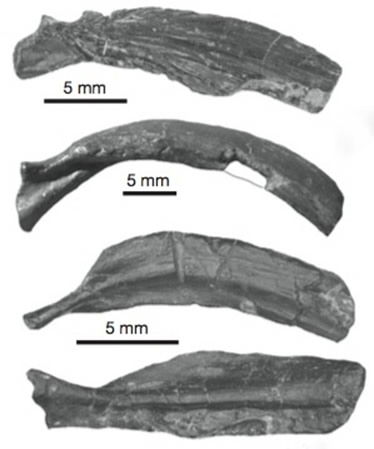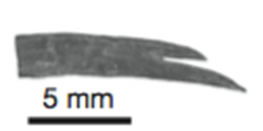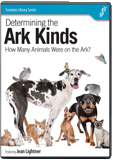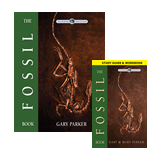
Is “Grandfather Turtle” the Transitional Form that Puts Creationist Claims to Rest?
News to Know
Abstract
How the turtle got its shell—another just-so story
News Source
Pappochelys, whose name means “grandfather turtle,” is the latest fossil to be called a “transitional form” or “missing link” in turtle evolution. (The last one was Eunotosaurus, which we discussed in “Turtle in the Gap.” Before that it was Odontochelys, discussed in “A Sea of Change for Turtle Origin Theories.”)
Pappochelys was found in Germany’s Middle Triassic Lower Keuper formation. It has an unusual skull and lacks a fused shell. Evolutionary scientists believe Pappochelys appeared 240 million years ago as a transitional step in the evolution of the turtle shell. The authors of the study describing “grandfather turtle” also believe its skull confirms that turtles evolved millions of years ago from lizard-like reptiles.

This is a sketch of the reconstruction of Pappochelys’s skeleton. The bones shown in grey and black are the fossils that have been found. The bones in black are the ribs and gastralia (rib-like bones protecting the abdomen).Image reproduced from Rainer Schoch and Hans-Dieter Sues, “A Middle Triassic Stem-turtle and the Evolution of the Turtle Body Plan,” Nature (June 24, 2015), doi:10.1038/nature14472. View larger image.
Turtle Shell Basics
The turtle shell, though highly variable, is unique in the animal kingdom. (Be sure to read more about its amazing architectural design features in “Walking Cathedrals.”) The typical turtle’s shell consists of a carapace on top and a plastron protecting its underbelly. Its closely spaced ribs have a broad upper surface with a ridge projecting below, giving each rib a cross sectional T-shape. This T-shaped rib is a signature feature of turtles whether the ribs are fused into a solid carapace or not.1 Furthermore, a turtle’s limbs are enclosed within its rib cage, a construction not seen in other vertebrates.

These are four of Pappochelys’s trunk ribs, showing (top to bottom) dorsal, anterior, and two ventral surfaces. The sculpturing on the dorsal surface is like that found on the ribs of the extinct turtle-like reptile, Eunotosaurus. The anterior surfaces of the ribs show no attachment points for intercostal muscles, which turtles do not have. And the ventral ridges forming the vertical part of two T-shaped ribs are easily seen in the ventral views. Such T-shaped ribs are typical of turtles. Image reproduced from Schoch and Sues, “A Middle Triassic Stem-turtle . . .” doi:10.1038/nature14472.

This is the distal end of two fused gastralia, the fusion being evidenced by the forked end. Image reproduced from Schoch and Sues, “A Middle Triassic Stem-turtle . . .” doi:10.1038/nature14472.
A turtle’s solid carapace is made of these broad T-shaped ribs fused with vertebrae or their broad protuberances and with dermal bone.2 A solid plastron is likewise composed of fused dermal bone and rib-like bones that protect the abdomen. All these carapacial and plastral dermal bones (osteoderms) are overlain with large, highly keratinized epidermal scales called scutes.3 Turtle shells clearly exhibit a high degree of morphological diversity. For instance, the pig-nosed turtle, softshell turtles, and leatherback turtles have a leathery covering instead of scutes. Softshell turtles have only a small amount of bone in the carapace, which is not fused to the plastron even in those species that have a bony plastron. And the carapace of leatherback turtles contains no bone at all.
Among animals there is no anatomical structure similar to a turtle shell to help evolutionists guess at relationships between turtles and other animals. This unique turtle feature, combined with genetic evidence seemingly at odds with the fossil record, has made it difficult for evolutionists to come up with consistent stories about the turtle’s ancestry.
Transitional Turtle?
Turtles with completely fused shells—Proganochelys—appear in the fossil record in Upper Triassic rock in Germany and Thailand. These turtles are dated to be about 215 million years old by evolutionary reckoning. Though they have teeth, they are otherwise quite like today’s living turtles, which are all toothless. Extinct turtles found in or below Middle Triassic rock formations lack fusion of the bones that would otherwise comprise a carapace, a plastron, or both. Even though there is much disparity in living turtles’ shells, evolutionists consider lack of fusion to be a primitive state. Many believe the fossil record of turtles reflects stages recapitulated by a turtle’s embryological development. By lining up extinct turtles from the fossil record, buried all over the globe in rock layers dated according to unverifiable worldview-based assumptions, evolutionary scientists seek to unravel the evolutionary history of the turtle and its shell. However, like the prevalence of the unfused state among turtles in some modern aquatic habitats, it is quite possible that these variations of turtles and turtle-like reptiles were suited to their pre-Flood environments. If their particular habitats were overwhelmed and catastrophically buried early in the upheavals associated with the global Flood, we would naturally find their fossils in sediment deposited some number of days or weeks before turtles anatomically equipped for different environments. The apparent progression of turtles through time is only an interpretation based on millions of years of evolutionary assumptions.
The date assigned to Pappochelys (240 million years) places it halfway between two other varieties of turtle purported to demonstrate how the turtle shell evolved: South Africa’s Eunotosaurus (dated at 260 million years) and China’s Odontochelys (dated at 220 million years). Paleontologists Rainer Schoch and Hans-Dieter Sues, coauthors of the study in Nature describing Pappochelys, thus assert they have discovered a missing link clarifying how both the turtle’s shell and skull evolved.

This chart published in Nature to depict transitional forms in turtle evolution lists not fossils showing evolutionary transitions as the authors intend but rather varieties of turtles that coexisted in the world at the time of the global Flood, which buried them a little less than 4,500 years ago. Image reproduced from Schoch and Sues, “A Middle Triassic Stem-turtle . . .” doi:10.1038/nature14472.
Pappochelys is about eight inches long, and half that length is a whip-like tail. Like Eunotosaurus and Odontochelys, Pappochelys has unfused, close set, T-shaped ribs. The ribs’ pronounced surface sculpturing and microscopic structure resemble that of Eunotosaurus.4 Most land vertebrates use their ribs like bellows to ventilate their lungs, and this requires the contraction of intercostal muscles between the ribs. Because turtles’ ribs are part of the armor protecting their backs, their ribs lack the mobility to assist with breathing. Terrestrial turtles have no intercostal muscles. Instead, muscles inside the rib cage help them move air. As in modern terrestrial turtles, the anterior surfaces of these extinct turtles’ ribs bear no evidence of attachments for intercostal muscles.5
Like Eunotosaurus and modern softshell turtles, Pappochelys has no plastron. Instead, the rib-like bones protecting its abdomen—called gastralia—are closely spaced and some seem fused, based on the fact that a few had forked ends.6 And because Odontochelys has a plastron but not a carapace, evolutionists believe the plastronevolved first and the carapace millions of years later. Again, these variations among extinct turtles are being interpreted through the presumed millions of years superimposed on the fossil record, whereas extant turtle species simply exhibit much morphological disparity.

This is Pappochelys’s skull and teeth, the recovered fossils shown in the drawing in gray. Similar teeth are also found in Odontochelys but not in Eunotosaurus or any living turtles. Pappochelys’s skull is very unusual for a turtle. It has two openings behind the eyes, whereas other turtles have none.Image reproduced from Schoch and Sues, “A Middle Triassic Stem-turtle . . .” doi:10.1038/nature14472.
Both Pappochelys and Odontochelys have peg-like teeth. Proganochelys also had teeth. Modern turtles do not. Teeth have not been reported in Eunotosaurus, presumed to be the oldest fossil reptile showing some turtle-like morphology though it lacks certain defining turtle characteristics.7 If the worldview-based dates assigned to the fossil record were really accurate, then it would appear turtles spent millions of years acquiring teeth and then lost them. Divested of those presumed millions of years, of course, we can see that these animals are simply varieties of turtles and turtle-like reptiles that coexisted at the time they were catastrophically buried during the global Flood of Noah’s day. It is important to note that if one presupposes common ancestry on the range of extinct turtle morphologies, one will always find what appear to be “transitional forms”.
Embryonic Hopes
During a turtle’s embryonic development its limbs must assume their unusual positions inside the rib cage and the components of its solid shell—if it has one—must fuse. Many evolutionists try to match up turtle fossils with steps in turtle embryology. Belief in embryonic recapitulation8—the notion that embryologic development will guide them to a correct historical account of the turtle’s evolutionary history —has gained much support among evolutionists interested in the history of the turtle shell, outstripping other views. However, there is nothing inherently primitive about having no carapace or an unfused carapace or plastron.
An embryo’s observable journey to its fully developed form involves changes guided by the genetic information that already exists, at that developmental stage and location, within that kind of animal. Embryonic development, because it lays out the steps that actually work in real time to form a single animal, helps evolutionists come up with a plausible sequence of changes that would be required if evolution of one kind of animal into a more complex one could occur. Evolutionary “phylogeny,” however, would involve transformation of one kind of animal into another through a step-wise process over millions of years. Embryonic development (ontogeny) is therefore clearly not comparable to evolutionary phylogeny. Embryonic development is not a reliable guide to how turtles evolved from some other kind of animal or even to how variations within the turtle kinds developed. (See “Recapitulation Theory: Repackaged & Re-Applied.”)
Windows in the Skull
Pappochelys’s skull is unusual for a turtle. Like most living reptiles but unlike all other turtles, Pappochelys has two pairs of openings behind its eyes. All modern turtles and—until now—all known fossilized turtles have been anapsids—reptiles with “windowless” skulls. A “double-windowed” reptilian skull—one with upper and lower temporal fenestrations—is called a diapsid skull.
Strong jaw muscles are located in the region of the skull where these fenestrations are (or are not, depending on the species). Anatomists are still determining all the ways these holes might influence the mechanics of chewing and biting. Lack of temporal fenestrations doesn’t impede the typical turtle’s ability to bite—just consider the snapping turtle!
Until now, however, the universal lack of temporal fenestrations in extant and extinct turtles has impeded evolutionary agreement about the ancestry of turtles. After turtles were reported in a 2011 molecular study9 to share four of the 77 microRNA families unique to lizards, many evolutionists concluded that the turtle’s ancestors must have been lizard-like diapsids and that turtles later lost their fenestrations over millions of years. (Read more about it in “Turtles Still Baffle Evolutionists.”) Of course, evolutionary scientists attribute such genetic similarity to common ancestry, ignoring the view that similarities, even in regulatory elements, can simply be due to common designs created by God.
In any case, lizards are diapsids, making the anapsid turtle skull a mystery that didn’t fit the evolutionary notion that turtles evolved from lizards. No diapsid turtle had ever been found, and now Pappochelys’s diapsid skull has broken the mold for the classic turtle skull. Furthermore, the authors point out that recent analysis of CT X-ray images of Eunotosaurus showed it actually had a lower fenestration as well as an upper fenestration hidden by a bone.10 They consider Pappochelys’s diapsid skull, particularly in view of Eunotosaurus’s oddly variant skull, evidence that turtles evolved from lizard-like diapsids as they already assumed.
Biodiversity and Common Designs
With shell characteristics like those of other extinct turtles and a diapsid skull, should creation scientists be having nightmares, as headlines suggest? Not at all. The order Testudines—including tortoises, sea turtles, and terrapins—boasts 14 families of living turtles. Recent analyses suggest that there may be as many as 13 created kinds of turtles still represented among those living, including two marine kinds. (See “An Initial Estimate toward Identifying and Numbering the Ark Turtle and Crocodile Kinds.”)
Living turtles exhibit great disparity. There is thus no reason to assume that the additional variations of turtles or turtle-like reptiles found in the fossil record are anything but other created kinds of turtles or simply other unique extinct reptiles that were catastrophically buried at the time of the global Flood less than 4,500 years ago but went extinct subsequent to the Flood.
Such variety is readily understandable within the parameters of the history God provides in His Word: God created all kinds of animals about 6,000 years ago, and they reproduce only within their created kinds. A created kind is a much broader category than “species.” God placed the potential for great variation within the original created kinds. Those variations, altered by genetic recombination, mutations, natural selection, and other mechanisms after the Fall led to the great diversity among turtles and all other living things today. Variations within a particular kind of animal do not lend support to millions of years of molecules-to-man evolution. Likewise, a few genetic similarities between lizards and turtles—just 4 of the 77 microRNA families—does not even imply common ancestry when we realize that experimental biology reveals no mechanism by which one kind of animal can acquire the genetic information to evolve into a different kind of animal.11
What are we to make of animals like these extinct turtles and turtle-like reptiles that combine a variety of morphological elements? After all, biologists and paleontologists “will continue to find creatures that look like missing links,” explains Dr. Gordon Wilson12 of New Saint Andrews University’s Department of Natural History, commenting on this series of turtles and turtle-like reptiles. Nevertheless, “They are most easily explained by a God who delighted in making a rich and complex living tapestry of immense biodiversity to fill the vast array of ecological niches in the pre-Flood world that was deluged. This variety can always have an evolutionary worldview superimposed on it.” As he has explained in Answers magazine’s “Pinnipeds—Blurring the Boundaries,” the abundant biodiversity among extant and extinct animals suggests that God wanted to fill the Earth’s many habitable niches:
It should come as no surprise that He made a startling array of creatures to fill them all.
When we understand that God is the master engineer who forms creatures perfectly suited to in-between habitats, we should realize the misuses of the term “transitional.” Such creatures are not transitional forms that have evolved midway from one form into another. Rather, their wonderfully designed bodies enable them to thrive in a different habitat, possibly intermediate between very different adjacent habitats.13
Pappochelys is not “the stuff of creationist nightmares” as the media claims. It is just another very interesting variety of turtle, a reminder of the lavish creativity and power of God. And these fossils are a reminder that the Creator is the same God who sent the global Flood as a judgment for the overwhelming sinfulness of mankind, the same God in whom Noah found grace (Genesis 6:8), and the same God who still today has saving grace (Romans 6:23; cf. Ephesians 2:8–10 and Romans 5:14–19) available in Jesus Christ for all who repent of their sin and anchor their lives in His sacrificial death and Resurrection.
Further Reading
For More Information: Get Answers
Remember, if you see a news story that might merit some attention, let us know about it! (Note: if the story originates from the Associated Press, FOX News, MSNBC, the New York Times, or another major national media outlet, we will most likely have already heard about it.) And thanks to all of our readers who have submitted great news tips to us. If you didn’t catch all the latest News to Know, why not take a look to see what you’ve missed?
(Please note that links will take you directly to the source. Answers in Genesis is not responsible for content on the websites to which we refer. For more information, please see our Privacy Policy.)
Footnotes
- The extinct marine reptiles known as saurosphargids also have broad ribs, but these differ from those of extinct turtles “in being flatter (with the shaft not offset), straighter, single-headed, and uniform throughout the trunk region.” From Rainer R. Schoch and Hans-Dieter Sues, “A Middle Triassic Stem-turtle and the Evolution of the Turtle Body Plan,” Nature (June 24, 2015), doi:10.1038/nature 14472.
- Dermal bone, also called intramembranous bone, is formed in the embryo or juvenile by intramembranous ossification within the dermis instead of by ossification of cartilage. In humans, for example, much of the skull, face, and jaw as well as the lateral part of each collarbone consist of dermal bone.
- Under the epidermal scutes are bony bases in the dermis called osteoderms.
- Schoch and Sues, “A Middle Triassic Stem-turtle . . .” doi:10.1038/nature14472.
- Muscles are not preserved in these fossils. The absence of intercostal muscles is deduced from the lack of Sharpey’s fibers in the anterior side of the ribs. Sharpey’s fibers are bundles of collagen fibers that attach muscles to the periosteum which in turn is attached to its underlying bone.
- The fossils were not intact and had to be reconstructed from fragments. However, some of the gastralia—the broad rib-like bones covering the abdomen—had forked ends, suggesting they were the remnants of two gastralia that had fused together. The authors write, “Successive gastralia occasionally fused to each other, as suggested by several particularly robust elements with forked distal ends.” From Schoch and Sues, “A Middle Triassic Stem-turtle . . .” doi:10.1038/nature14472.
- A turtle’s pectoral girdle—the bones that attach the front limbs to the vertebral column—is located inside the rib cage. The pectoral girdle of Eunotosaurus is located outside the rib cage, like that of other vertebrates. Also, as explained in footnote 10, the skulls of both Eunotosaurus and Pappochelys are each unique, differing from usual turtle skull morphology.
- Embryonic recapitulation is the belief that observable embryonic development in a particular species is like a roadmap of that animal’s evolutionary history. The “theory” of embryonic recapitulation is summed up by the catchy but false claim, “Ontogeny recapitulates phylogeny.” Ontogeny refers to the steps in the embryonic development of an animal. Phylogeny refers to an animal’s presumed evolutionary line of descent. Read more about the history of the fraudulent support used to popularize this notion and the many ways in which evolutionists have clung to this illogical and insupportable yet very convenient belief in the article “Recapitulation Theory: Repackaged & Re-Applied.”
- Lyson et al., (in “MicroRNAs Support a Turtle + Lizard Clade,” Biology Letters [July 20, 2011], doi:10.1098/rsbl.2011.0477), reported that turtles share four of the 77 microRNA gene families specific to lizards. Read more about it in “Turtles Still Baffle Evolutionists.” MicroRNA molecules are not involved in protein production but instead regulate the expression of many genes. Expression of genes common to different organisms can be regulated by specific microRNA molecules, resulting in major morphological differences. Evolutionists believe that new microRNA molecules take millions of years to evolve and that once they are established in a particular lineage they are rarely lost.
-
Schoch and Sues write, “The presence of two temporal openings on either side of the cranium in Pappochelys supports the hypothesis of diapsid affinities for turtles. . . . Similarly, the skull of Eunotosaurus was long considered ‘anapsid’ but, like Pappochelys, it has ventrally open lower temporal openings. Furthermore, new research indicates that Eunotosaurus has upper temporal openings concealed by large supratemporals” (Schoch and Sues, “A Middle Triassic . . .”). These facts about Eunotosaurus were reported by Bever, Lyson, and Bhullar at the November 2014 Society of Vertebrate Paleontology’s 74th Annual Meeting. The abstract from that meeting confirms that, based on analysis of CT images of fossil skulls, Eunotosaurus had “ventrally unbounded LTF [lower temporal fenestra]” as well as “a moderate-sized opening circumscribed by the same elements that define the UTF [upper temporal fenestra]” covered by a supratemporal bone. (From G.S. Bever, T. Lyson, and B-A Bhullar, “Fossil Evidence for a Diapsid Origin of the Anapsid Turtle Skull,” Society of Vertebrate Paleontology, November 2014, Abstracts, 92.)
Of course the authors of both studies consider this discovery to be evidence that Eunotosaurus was a transitional form early in the history of turtle evolution from other diapsid reptiles. Since biological observations have never shown how one kind of animal could obtain the genetic information to evolve into a different kind of animal, it makes more sense to understand that the skull variations in Eunotosaurus, like those in Pappochelys, demonstrate the created disparity and spectrum among turtles and/or other reptiles possessing some turtle characteristics.
- These animals of course share a common Creator, and as such it is no surprise to find a few common design elements. The observation of common design elements, however, cannot prove either their common ancestry or their common Creator’s hand because the time of their origins cannot be observed through scientific means. Nevertheless, the evolutionary interpretation requiring animals to acquire the genetic information to change into a completely different kind of animal remains outside anything observed in experimental biology.
- Dr. Gordon Wilson, senior fellow of natural history at New Saint Andrews College, earned his PhD from George Mason University in environmental science and public policy. He holds a master of science degree in entomology from the University of Idaho. Many of his contributions to Answers magazine are available on this website at “Latest Articles by Dr. Gordon Wilson,” including “Eastern Box Turtles—Frozen Alive!” Dr. Wilson’s PhD research concerned the reproductive ecology of the eastern box turtle.
- Gordon Wilson, “Pinnipeds—Blurring the Boundaries,” Answers, October 1, 2013, https://answersingenesis.org/mammals/pinnipeds-blurring-the-boundaries/.
Recommended Resources

Answers in Genesis is an apologetics ministry, dedicated to helping Christians defend their faith and proclaim the good news of Jesus Christ.
- Customer Service 800.778.3390
- © 2024 Answers in Genesis




